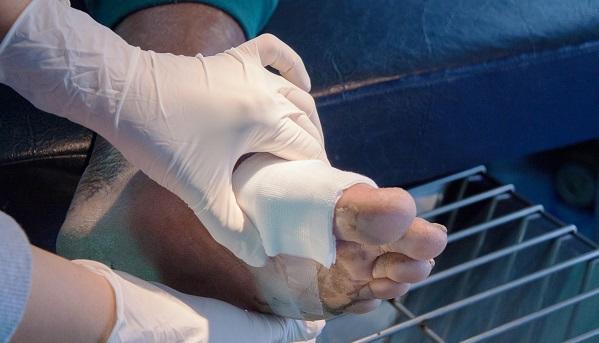Critical Limb Ischemia During COVID: Lessons for Care and Clinical Trials
Amputations rose in New York, the UK expanded “hot clinics,” and the FDA worked to understand the impact on trialists.

The COVID-19 pandemic has had repercussions for patients with peripheral artery disease that range from increased amputations to payoffs in terms of efforts to keep patients out of hospitals while still complying to treatment recommendations, experts said in a session at last week’s Charing Cross International Symposium (CX2021), held virtually this year.
Trying to make sense of it all, moderator Michael Edmonds, MD (King’s College, London, England), noted that the information surrounding COVID-19’s effects on amputations has been “confusing and controversial.”
The session, called “The Hurting Leg,” gave a glimpse into how clinicians and their patients navigated the worst of the pandemic in 2020, recalling failures and some triumphs during a time of extreme disconnect for the vascular community, and medicine in general.
In one presentation, Alisha Oropallo, MD (Northwell Health Wound Institute, New Hyde Park, NY), described a retrospective review of lower limb amputation rates at a 23-hospital system in New York. The study ranged from December 2019 to September 2020, allowing for comparison of the 3-month periods before, during, and after the height of pandemic cases in New York.
Oropallo said she and her colleagues believe the data reflect lack of access to vascular specialists who otherwise would have been able to prevent the excess limb amputations. She noted that from March to May 2020, non-COVID patients with lower-extremity wounds were only admitted at her hospital system on an emergency basis, leaving patients with chronic wounds little option beyond telehealth services, a situation that likely increased their risk of progressing to vascular insufficiency during that time and beyond.
“Despite the regain of healthcare accessibility, the long-term negative impact of COVID-19 has yet to be determined,” Oropallo noted, adding that her group is continuing to collect data on these patients.
In response to a question from Edmonds, Oropallo noted that despite the increased amputations, they have not seen an increased mortality rate among these patients.
Edmonds also speculated that the need to get patients out of the hospital quickly may have led to shorter stays, with patients being discharged before their infections or wounds were well controlled. Oropallo said one of the problems with trying to parse those data is that some patients were sent to subacute settings, and those “moving parts” coupled with the pandemic constraints makes it difficult to understand exactly what happened.
Hot Clinics: Opportunity in a Crisis
In another presentation, James Morris, MBBS (Lancashire Teaching Hospitals NHS Foundation Trust, Preston, England), described the different approach taken in his country, one that might have helped to avoid the types of increases in New York described by Oropallo. In recent years, the United Kingdom has expanded “hot clinics” to improve access and treatment times for patients with critical limb ischemia (CLI). Three clinics were added in 2020. Morris described the facilities as a “one-stop service for CLI patients”—they provide imaging, preoperative workup, multidisciplinary team discussion, and revascularization as an alternative to hospital admission.
Morris and colleagues looked at the impact of the additional clinics on time to referral for treatment from November 2019 to November 2020. Similar to Oropallo’s study, the observational period was broken down into 4-month periods before, during, and after suspension of routine health services due to the pandemic.
Of 234 patients referred to a CLI hot clinic, 188 attended. The average age was 72 years, and most subjects were male. In all, 114 (60.1%) patients were scheduled for revascularization (38 for open surgery, 54 for endovascular, and 22 for a hybrid procedure). The rate of amputation-free survival was 77.2%.
Morris and colleagues found a significant increase in the proportion of patients seen at hot clinics, ranging from 33.3% during November 2019-February 2020 to 38.6% during March-June 2020, then rising to a high of 71% during July-November 2020 (P = 0.0002). Similarly, the proportion of patients in each of the time periods who met the Vascular Society of Great Britain and Ireland’s recommendation for a time from referral to treatment of 14 days also improved from 9.7% prior to the pandemic to a high of 38.1% in March-June 2020, before leveling off to 20.9% in July-November 2020. There also was a reduction in the median time from referral to treatment over the study period, from 38 days, to 22 days, to 23 days, respectively (P = 0.004).
Noting that the hot clinics appear to have had “a major effect on care,” Edmonds asked if they will continue beyond the pandemic.
Morris said he believes they will, noting that data prior to the pandemic had shown decreases in morbidity, mortality, and readmissions for CLI patients using the clinics. Despite the negative impact of COVID-19 on patient care, he said the hot clinics were typically located in areas where patients would otherwise have to travel long distances to a medical center for assessment and treatment due to limited availability of specialists and/or long wait times. Morris said there are also implications for economically disadvantaged areas to benefit from implementation of hot clinics.
Pandemic Effect on CLTI Research
In another presentation, Misti Malone, PhD (US Food and Drug Administration, Silver Spring, MD), described how the FDA has been working with clinical trialists throughout the pandemic to support ongoing research efforts for chronic limb-threatening ischemia (CLTI).
In addition to the increase in amputations due to fewer visits to limb-preservation and wound-care specialists, she said there have been reports of unacceptably high major amputation rates in patients with diabetic foot ulcers during the pandemic. As such, “when evaluating data from clinical trials, it will be important to account for observed versus pre-COVID expected event rates,” she said, as well as take into account the local impact of COVID-19 rates on trial data.
“This may be of particular importance in CLTI trial endpoints including amputation-free survival and wound healing, which [have] been impacted by access to care and lifestyle changes,” Malone noted. “Additionally, interpretive ability of single-arm trials may be challenging due to lack of concurrent control, especially in the complex patient population where less is known, whereas the impact of RCTs may be less concerning. Therefore, it's important to plan additional statistical analysis to support clinical interpretation of data.”
She added that the FDA recognizes “the importance to remain agile in our response to the pandemic and flexible to interpret clinical data from this very unique time in our history, in order to bring safe and effective devices to patients.”
Program chairman Roger Greenhalgh, MD (Imperial College, London, England), asked Malone if the alternative approaches to monitoring “will be sustained long term even when COVID is over, or will you see the monitoring system for clinical trials going back to more traditional methods of verification and audit?”
“I can tell you my hope is that we're going to learn from the pandemic, and we will innovate and support more remote monitoring, especially in international trials,” Malone responded. “There's been a challenge for US-based companies to travel abroad and be able to monitor or be present during procedures. So, some clinical trials abroad have completely stopped during the pandemic.” She added that lessons learned from pandemic-era virtual visits and hot clinics are important, and may pave the way to improve clinical infrastructure.
L.A. McKeown is a Senior Medical Journalist for TCTMD, the Section Editor of CV Team Forum, and Senior Medical…
Read Full BioSources
Oropallo A. The effect of COVID-19 on amputation rates across a twenty-three hospital system. Presented at: CX 2021. April 22, 2021.
Morris J. Opportunity from crisis: reducing time to treatment for critical limb ischemia patients during the coronavirus pandemic by expanding a regional Hot Clinic service. Presented at: CX 2021. April 22, 2021.
Malone M. Clinical evaluation of CLTI patients and other frail patients in the era of COVID-19. Presented at: CX 2021. April 22, 2021.
Disclosures
- Oropallo, Morris, and Malone report no relevant conflicts of interest.





Comments